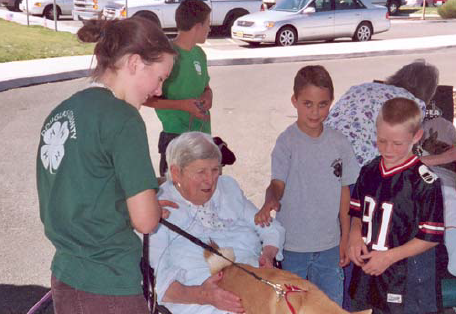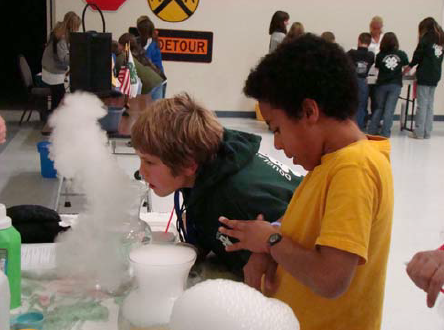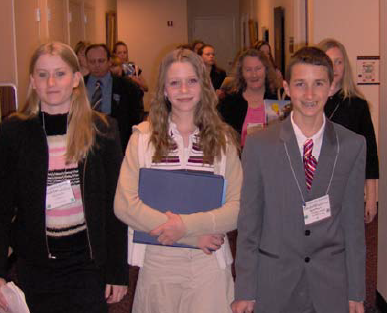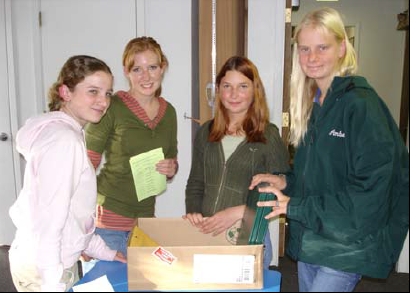Today’s youth have many options to choose from when selecting extracurricular activities. Youth sports, electronic games, faith-based activities, school clubs, local parks and recreation facilities are a few of the options from which to choose. So why might a family consider 4-H as one of the top options? Read on to discover how youth with Nevada 4-H experience differ from those with none.
In a 2007 survey of nearly 1,500 Nevada public school fifth, seventh, and ninth grade students – youth belonging to a 4-H Club that met formally outside of school were found to:
- Express stronger care for others
- Engage in more organized youth activities
- Participate in more school leadership opportunities
- Possess higher self-confidence, character and empowerment…
than those without any 4-H experience.
Introduction
In the spring of 2007, a study was conducted to measure impacts of the 4-H experience on the lives of Nevada youth. Anecdotal evidence has been widely used over the last 100 years to show 4-H is effective in helping youth grow into productive citizens. This type of accountability reporting has, in recent years, been viewed as less reliable than more formal evaluation studies (Goodwin et al., 2005; Gruidi & Hustedde, 2003; Karr et al., 2001; Seevers, Dormody & Clason, 1995; Scholl & Lago, 1994; Boyd, Herring & Briers, 1992). Federal, state, and county monies support 4-H programs coordinated by Land Grant College and Cooperative Extension systems. Accountability of these funds is of paramount importance to ensure continued support. Cooperative Extension has the duty to accurately measure program effectiveness and report findings to our funding sources.
Study Data
Data were collected from fifth, seventh, and ninth grade students in one urban and five rural Nevada public schools districts that were randomly selected. The Research Randomizer (2006) was used to randomize districts and schools within districts. A 65-item questionnaire was administered to students in 16 urban schools and 22 rural schools across the state with a 34 percent response rate. The questionnaire was provided in both English and Spanish forms. Over one-half, 52.3 percent, of the 1,492 survey participants, were female, and 47.7 percent were male, while 63.1 percent of the survey respondents were from the urban school district, and 36.9 percent were from the rural districts. One hundred sixty-six students, 11.8 percent of the respondents, indicated they had been involved in 4-H. The majority of students, 88.2 percent never belonged to 4- H. The sample population was evenly distributed across three age groups with 39.7 percent of the students 10-12 years old, 28.8 percent 13-14 years old, and 31.5 percent 15-18 years old. Data were analyzed with SPSS 15.0 for Windows.
Findings
Results confirm that youth with 4-H experience differ in four significant ways from youth with no 4-H experience. 4-H youth participating in the study expressed a strong care for others; engaged in more organized youth activities; participated in more school leadership opportunities; and possessed higher self-confidence, character and empowerment, than youth without any 4-H experience. These differing characteristics are described in more detail below.
4-H Youth: Caring for Others
Youth with 4-H experience are significantly more likely than other youth that completed the questionnaire to: (see Table 1.)
- Help others in school
- Be involved in projects to help make life better for other people
- Give money or time to a charity or organization that helps people
- Spend time helping people who are poor, hungry, sick, or unable to care for themselves

4-H Youth: Engaged in Organized Activities
Youth with 4-H experience are significantly more likely than other youth that completed the questionnaire to spend time during the school week in:
- Drama, art, dance, band, choir, orchestra, music lessons, practicing voice or an instrument
- Playing on, or helping with, sports teams at school or in the community
- Other school clubs or organizations such as school newspaper, student government, school plays, language clubs, hobby clubs, debate, etc.
- Clubs or organizations (other than sports) outside of school such as Scouts, Boys and Girls Clubs, YWCA, YMCA, etc.
- Services, groups or programs of a spiritual nature

4-H Youth: Engaged in Leadership
In school this past year, youth with 4-H experience were significantly more likely than other youth that completed the questionnaire to: (see Table 3.)
- Be elected to a leadership position
- Hold any leadership position
- Serve as a committee chairperson
- Serve as a committee member

4-H Youth: Confident and Empowered
Youth with 4-H experience are significantly more likely than other youth that completed the questionnaire to feel that: (see Table 4)
- Adults in their town or city make them feel important
- In their town or city, they feel like they matter to people
- They’re given lots of chances to help make their town or city a better place to live
- They have good written-record-keeping skills

Limitations
The reader should use caution when transferring these results to other populations. The potential for sampling error severely limits the generalizability of the findings. The study is cross-sectional and cannot infer causality. Additionally, the data are self-report and thus subject to bias.
Conclusion
Results indicate that youth who have been involved in Nevada 4-H programming have some character and behavior traits that differ from youth who have never been involved in 4- H. In particular, youth involved in 4-H are more likely to engage in other organized activities in and out of school, participate in more school leadership roles, care and contribute to the well-being of more people in need and have higher self-confidence, character and empowerment than youth that have never been involved in 4-H. Study results confirm that 4-H programming is making a notable impact on the lives of Nevada youth and is an excellent extracurricular activity for families to consider.
References
Boyd, B.L., Herring, D.R., & Briers, G.E. (1992). Developing life skills in youth. Journal of Extension, 30(4). Retrieved on October 17, 2007
Goodwin, J, Barnett, C., Pike, M., Peutz, J., Lanting, R., & Ward, A. (2005). Idaho 4-H impact study. Jnoural of Extension, 43(4). Retrieved on October 17, 2007
Gruidl, J., & Hustedde, R. (2003). Evaluation of capacity-building programs: A learning organization approach. Journal of Extension, 41(5). Retrieved on October 17, 2007
Karr, K., Keith, L., Vaugh, P., & Lockaby, J. (2001). The self-perceived impact of participation in the Texas 4-H council by former council members. Texas 4-H Research Review: 2000-2001. Office for Texas 4-H and Youth Research. College Station, TX: Texas A&M University.
Research randomizer. (2006). Retrieved October 17, 2007, from: Randomizer.
Scholl, J. & Lago, D. (1994). Using non-reactive methods to study and improve 4-H programs. Journal of Extension, 32(3). Retrieved on October 17, 2007
Seevers, B.S., Dormody, T.J., & Clason, D.L. (1995). Developing a scale to research and evaluate youth leadership life skills development. Journal of Agricultural Education, 36(2), 28-34.
Table 1 4-H Participation Comparison in Caring for Others
| Type of Help |
Non 4-H Youth %
|
Non 4-H Youth n
|
4-H Youth %
|
4-H Youth n
|
| Helped Others in School |
*85.0 |
1052 |
*92.1 |
152 |
| Help Project to Make Life Better |
*45.9 |
566 |
*62.8 |
103 |
| Time or Money to Charity |
*48.4 |
595 |
*58.2 |
96 |
| Helped Sick, Poor, Hungry |
*36.8 |
450 |
*52.4 |
86 |
*p < .05
Table 2 4-H Participation Comparison in Extracurricular Activity Involvement
| Activities |
Non 4-H Youth %
|
Non 4-H Youth n
|
4-H Youth %
|
4-H Youth n
|
| Drama, Art, Music |
*37.4 |
430 |
*48.1 |
75 |
| Sports Teams |
*49.7 |
576 |
*67.7 |
107 |
| School Clubs |
*17.7 |
202 |
*29.4 |
45 |
| Outside School Club |
*18.9 |
215 |
*35.2 |
55 |
| Spiritual |
*24.2 |
274 |
*31.8 |
49 |
*p < .05
Table 3 4-H Participation Comparison in School Leadership Positions Held
| Position Type |
Non 4-H Youth %
|
Non 4-H Youth n
|
4-H Youth %
|
4-H Youth n
|
| Elected Leadership |
*11.4 |
136 |
*20.1 |
32 |
| Held Leadership Position |
*12.9 |
153 |
*20.1 |
32 |
| Committee Chair |
*5.1 |
63 |
*9.8 |
16 |
| Committee Member |
*9.3 |
115 |
*15.9 |
26 |
*p < .05
Table 4 4-H Participation Comparison in Self-Confidence, Character and Empowerment
| Statements |
Non 4-H Youth Mz
|
Non 4-H Youth SD
|
4-H Youth M
|
4-H Youth SD
|
| Adults in my town or city make me feel important |
*3.22 |
1.047 |
*3.46 |
1.110 |
| In my town or city, I feel like I matter to people |
*3.26 |
1.024 |
*3.49 |
1.033 |
| I’m given lots of chances to help make my town or city a better place to live |
*2.89 |
1.077 |
*3.44 |
1.084 |
| I have good written record keeping skills |
*2.44 |
1.210 |
*2.82 |
1.243 |
zMeans of Likert scale responses (1 = strongly disagree, 2 = disagree, 3 = neutral, 4 = agree, 5 = strongly agree)
*p < .05


